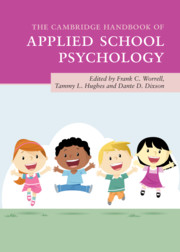Book contents
- The Cambridge Handbook of Applied School Psychology
- The Cambridge Handbook of Applied School Psychology
- Copyright page
- Contents
- Contributors
- Contributor Biographies
- Acknowledgments
- 1 Broadening the Focus of School Psychology Practice
- Part I Individual-Level Academic Interventions
- Part II Teacher- and System-Level Interventions
- Part III Interventions from Educational and Social/Personality Psychology
- Part IV Behavioral and Social-Emotional Interventions
- Part V Health and Pediatric Interventions
- Part VI Family Connections and Life Transitions
- Part VII Special Populations
- 33 School Psychologists in Early Childhood Settings
- 34 Identifying and Serving Gifted and Talented Students
- 35 How Best to Serve Court-Involved Youth in Schools
- 36 School-Based Interventions for Refugee Children and Adolescents
- Part VIII Conclusion
- Index
- References
36 - School-Based Interventions for Refugee Children and Adolescents
from Part VII - Special Populations
Published online by Cambridge University Press: 18 September 2020
- The Cambridge Handbook of Applied School Psychology
- The Cambridge Handbook of Applied School Psychology
- Copyright page
- Contents
- Contributors
- Contributor Biographies
- Acknowledgments
- 1 Broadening the Focus of School Psychology Practice
- Part I Individual-Level Academic Interventions
- Part II Teacher- and System-Level Interventions
- Part III Interventions from Educational and Social/Personality Psychology
- Part IV Behavioral and Social-Emotional Interventions
- Part V Health and Pediatric Interventions
- Part VI Family Connections and Life Transitions
- Part VII Special Populations
- 33 School Psychologists in Early Childhood Settings
- 34 Identifying and Serving Gifted and Talented Students
- 35 How Best to Serve Court-Involved Youth in Schools
- 36 School-Based Interventions for Refugee Children and Adolescents
- Part VIII Conclusion
- Index
- References
Summary
Children and youth under the age of 18 make up more than half of the world’s 25 million refugees, putting pressure on school psychologists to provide targeted psychoeducational services. Schools are inadequately prepared for the growing enrolment of refugee youth, due to lack of professional expertise and limited resources. This chapter begins with an overview of the preflight, flight, and resettlement experiences that impact the child’s development, learning, and well-being. Next, we draw upon cognitive-developmental theory as a foundation for school-based service delivery. We then appraise trauma-informed care (an approach that has been well regarded in clinical practice), and review the evidence base of school-based mental health interventions. Given that the majority of refugee youth may be affected in ways that might not be adequately explained by symptomatology, we recommend that services address broader psychoeducational concerns. We conclude with suggested guidelines for effective school-based service delivery.
Keywords
- Type
- Chapter
- Information
- The Cambridge Handbook of Applied School Psychology , pp. 634 - 654Publisher: Cambridge University PressPrint publication year: 2020

